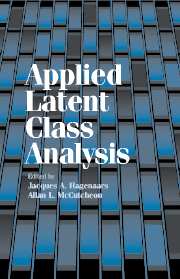Book contents
- Frontmatter
- Contents
- Contributors
- Preface
- INTRODUCTION
- CLASSIFICATION AND MEASUREMENT
- CAUSAL ANALYSIS AND DYNAMIC MODELS
- UNOBSERVED HETEROGENEITY AND NONRESPONSE
- 12 A Latent Class Approach to Measuring the Fit of a Statistical Model
- 13 Mixture Regression Models
- 14 A General Latent Class Approach to Unobserved Heterogeneity in the Analysis of Event History Data
- 15 Latent Class Models for Contingency Tables with Missing Data
- Appendix A: Notational Conventions
- Appendix B: Further Readings
- Appendix C: Selected Software; Webpage
- Index
12 - A Latent Class Approach to Measuring the Fit of a Statistical Model
Published online by Cambridge University Press: 31 July 2009
- Frontmatter
- Contents
- Contributors
- Preface
- INTRODUCTION
- CLASSIFICATION AND MEASUREMENT
- CAUSAL ANALYSIS AND DYNAMIC MODELS
- UNOBSERVED HETEROGENEITY AND NONRESPONSE
- 12 A Latent Class Approach to Measuring the Fit of a Statistical Model
- 13 Mixture Regression Models
- 14 A General Latent Class Approach to Unobserved Heterogeneity in the Analysis of Event History Data
- 15 Latent Class Models for Contingency Tables with Missing Data
- Appendix A: Notational Conventions
- Appendix B: Further Readings
- Appendix C: Selected Software; Webpage
- Index
Summary
INTRODUCTION
Traditional approaches to measuring the fit of a statistical model are based on comparing the actual data to the expectation of the observations under the assumption that the model is true. The resulting statistics can be given a strict test of fit or a measure of fit interpretation. Carrying out a test of fit is possible only if the distribution of the statistic is known. A proper interpretation of a measure of fit also requires knowledge regarding its distribution. These procedures are error prone for two reasons. First, when the model is not true, a comparison of the data to what could only be expected if it was, is of very little meaning. Second, the actual distribution of the statistic may be very different from the reference distribution if some of the underlying assumptions are violated. A more detailed account of these problems in the context of models for contingency tables is given in Section 2; in this case, serious additional problems may arise because of small or large samples.
In this chapter, an alternative approach to measuring the fit of a statistical model will be described, which is not affected by most of the problems referred to earlier. We will abandon the idea that a simple model may describe the entire population.
- Type
- Chapter
- Information
- Applied Latent Class Analysis , pp. 345 - 365Publisher: Cambridge University PressPrint publication year: 2002
- 2
- Cited by



